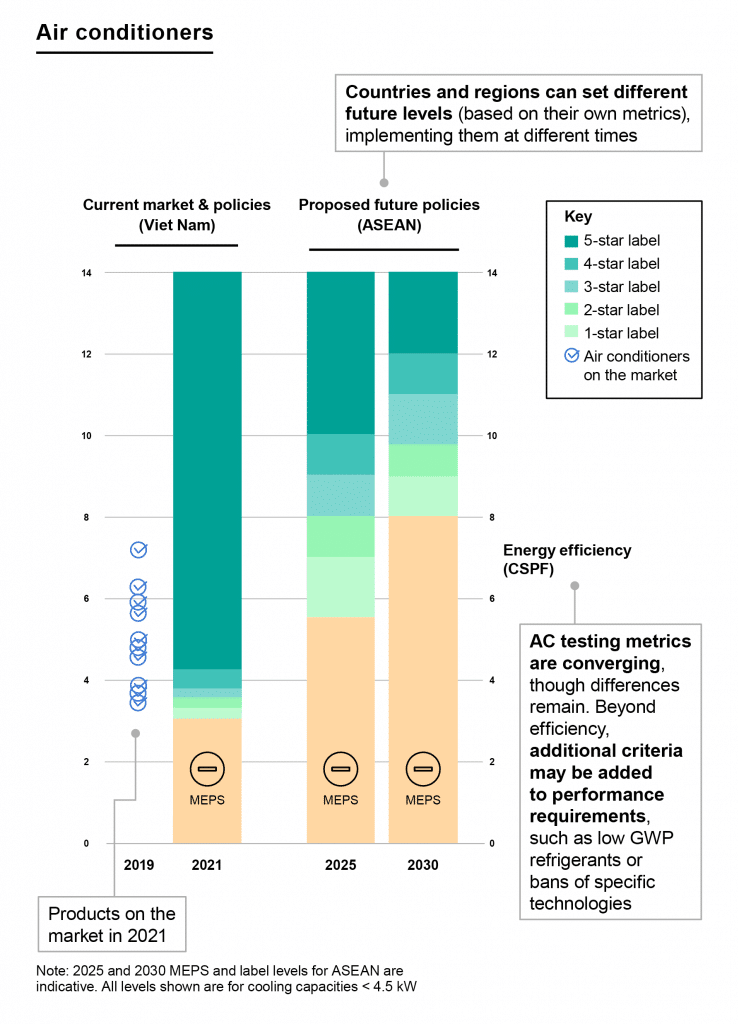Residential Air Conditioners (ACs)
Since 1990, energy consumption for space cooling has more than tripled, with significant implications for greenhouse gas emissions and electricity grids, especially during peak demand periods. Globally, there are about 2 billion air conditioners (ACs) in use, of which nearly two thirds are located in China and the United States. These ACs vary enormously in their energy efficiency performance, and according to analysis by the International Energy Agency, keeping them running consumes over 2 000 terawatt hours (TWh) of electricity every year. Without action to address energy efficiency, energy demand for space cooling will more than triple by 2050 – consuming as much electricity as all of China and India today.
In a hypothetical situation in which the efficiency of new residential ACs sold globally doubled from 2022 onwards, the potential global annual electricity reduction in 2030 could avoid over 500 (MtCO2) energy-related emissions. Under the same scenario, SEAD member countries alone could avoid almost 400 (MtCO2) energy-related emissions in the same year.
Current policy coverage in standards and labels
There is an opportunity to quickly influence the growth of cooling related energy demand through policies to improve efficiency. Through more stringent minimum energy performance standards (MEPS) and other measures such as labelling, the average energy efficiency of the stock of ACs worldwide could more than double between now and 2050. Most recently, Benin (2020) and Rwanda (2021) introduced mandatory policies, bringing the global count of countries with such policies to 83 for MEPS and 76 for comparative labels. Mandatory ACs standards now cover 85% of global space cooling energy consumption, up from two thirds in 2010. Additional MEPS are currently under development in more than 20 countries. MEPS standards and labels have recently been strengthened in Australia, Brazil, China and India. The latter also introduced voluntary labels for light commercial air conditioners in 2020.
The Energy Performance Ladder
To support the growth of markets for efficient appliances, the SEAD Initiative has developed the Energy Performance Ladder framework, which brings together multiple policies under a single consistent set of performance thresholds. These Ladder ‘steps’ are defined as energy performance levels using a standard test procedure. Governments can then set policy thresholds (such as MEPS, labels and high energy performance standards or HEPS) at different steps, as well as years in which the thresholds will move up the ladder.
The Ladder then provides a framework that can:
- Show a clear trajectory for improving appliance energy performance over time, by defining how policy will move up the ladder in future
- Benchmark energy performance across markets, while allowing policy to be set that is suitable for local market condition
- Aggregate markets to reduce costs and make highly efficient products more widely available.
An illustration of the Energy Performance Ladder for residential ACs is depicted below. Current (Viet Nam) and proposed (ASEAN) MEPS for each star rating are defined in each Ladder step .
Countries and regions can set different future levels (based on their own metrics), implementing them at different times. AC testing metrics are converging, though differences remain. Beyond efficiency, additional criteria may be added to performance requirements, such as low GWP refrigerants or bans of specific technologies.
